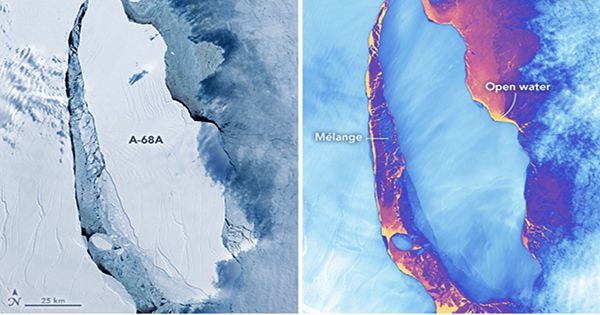A huge iceberg about the size of Los Angeles has smashed the border Brent ice shelf off the Antarctic coast of Coates Land. The iceberg captured measuring 1,270 square kilometers (490.3 square miles).
In the following weeks and months, researchers will see if it has moved away from the southern continent or will remain near the ice shelf. The entire Brent ice shelf has considered at risk of major break-offs over the past decade. A number of buildings have built over time, but a new one – known as the North Reef – began its journey back to another flame last November.

By January, the crater was running through a shelf of about one kilometer (0.6 miles) to 150 meters (492 feet) thick floating ice. This was a clear indication that a sinking event was imminent. This has now confirmed. Professor Dame Jane Francis, Director of British Antarctic Survey, said in a statement, “Our teams at BAS have been ready to make an iceberg from the Brant Ice Shelf for years. We monitor the ice shelf every day using an automated network of high-precision GPS devices around the station, measuring how this ice shelf is evolving and moving.”
“We also use satellite imagery from ESA, NASA and the German satellite TerraSAR-X. All data sent back to Cambridge for analysis, so we know what is happening even in the Antarctic winter, when there is no staff at the station, it is pitched black, and the temperature drops below minus 50 degrees C (or -58F).”
The previous two cracks on the Brute Ice Shelf were of great concern to the British Antarctic Survey, known as “Chasm1” and “Halloween Crack”. So much that in 2016, the Haley Research Center relocated within 32 kilometers (20 miles). The following year, the BAS decided not to present staff there during the winter months, when it would be difficult to remove. These two cracks have not grown in a while, but you are sure how dangerous these events can be when you can go from a crack to a huge iceberg in a matter of months.
“This is a dynamic situation. Four years ago we moved inward to the Haley Research Station to make sure that no iceberg would be carried once it was finally formed. It was a wise decision. Our job now is to closely monitor the situation and assess any potential impact of the current calf on the remaining ice shelves. As Simon Garrod, director of operations for the British Antarctic Survey, explains, we are constantly reviewing our ongoing plans to ensure the safety of our staff, to secure our research center and to maintain the science we have adopted in Halley.











